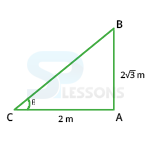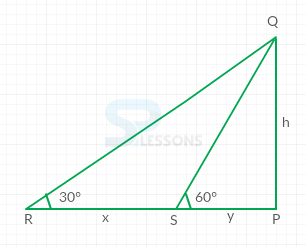 Introduction
Introduction
Height - Distance Problems mainly discusses about the right angled triangle, its trigonometrical identities, values of T-ratios, angle of elevation, and angle of depression.
Quantitative Aptitude -BANKING|SSC|RAILWAYS|INSURANCE|RECRUITMENT EXAMS - EBOOKS
 Methods
Methods
Consider a right angled triangle [latex]\bigtriangleup[/latex] ABC, Where [latex]\angle[/latex]ACB = [latex]\theta[/latex],
1. Sin[latex]\theta[/latex] is equal to ratio between perpendicular and hypotenuse.
2. Cos[latex]\theta[/latex] is equal to ratio between base and hypotenuse.
3. Tan[latex]\theta[/latex] is equal to ratio between perpendicular and base.
4. Cosec[latex]\theta[/latex] is the inverse of sin[latex]\theta[/latex].
5. Sec[latex]\theta[/latex] is the inverse of cos[latex]\theta[/latex].
6. Cot[latex]\theta[/latex] is the inverse of tan[latex]\theta[/latex].
Values of T-ratios:
Angle of elevation:
Assume that a person from a point O looks up at an object A, placed above the level of eye. Then, the angle which the line of sight makes with the horizontal through O, is called angle of elevation of A as seen from O.
Therefore, Angle of elevation of A from O = [latex]\angle[/latex]BOD.
Angle of Depression:
Assume that a person from a point O looks down at an object B, placed below the level of eye, then the angle which the line of sight makes with the horizontal through O, is called the angle of depression of B as seen from O.
Example 1:
If the height of a pole is [latex]2\sqrt{3}[/latex] meters and the length of its shadow is 2 meters, find the angle of elevation of the sun.
Solution:
| [latex]\theta[/latex] | [latex]0^{\circ}[/latex] | [latex](\frac{\pi}{6}) \\ {30}^{\circ}[/latex] | [latex](\frac{\pi}{4}) \\ {45}^{\circ}[/latex] | [latex](\frac{\pi}{3}) \\ {60}^{\circ}[/latex] | [latex](\frac{\pi}{2}) \\ {90}^{\circ}[/latex] |
|---|---|---|---|---|---|
| Sin[latex]\theta[/latex] | 0 | [latex]\frac{1}{2}[/latex] | [latex]\frac{1}{\sqrt{2}}[/latex] | [latex]\frac{\sqrt{3}}{2}[/latex] | 1 |
| Cos[latex]\theta[/latex] | 1 | [latex]\frac{\sqrt{3}}{2}[/latex] | [latex]\frac{1}{\sqrt{2}}[/latex] | [latex]\frac{1}{2}[/latex] | 0 |
| Tan[latex]\theta[/latex] | 0 | [latex]\frac{1}{\sqrt{3}}[/latex] | 1 | [latex]\sqrt{3}[/latex] | not defined |
- Let AB be the pole and AC be its shadow.
Let angle of elevation, ∠ ABC = θ.
Then, AB = [latex]2\sqrt{3}[/latex]m, AC = 2m.
tan θ = [latex]\frac{AB}{AC}[/latex] = [latex]\frac{2\sqrt{3}}{2}[/latex] = [latex]\sqrt{3}[/latex]
θ = 60°
So, the angle of elevation is 60°
- Let AB be the wall and BC be the ladder.
Then, ∠ ABC = 60° and BC = 19 m.
Let AC = x meters
[latex]\frac{AC}{BC}[/latex] = cos 60°
[latex]\frac{x}{19}[/latex] = [latex]\frac{1}{2}[/latex]
[latex]x[/latex] = [latex]\frac{19}{2}[/latex] = 9.5.
Distance of the foot of the ladder from the wall = 9.5 m.
- Let AB be the tower and C and D be the points of observation. Then,
[latex]\frac{AB}{AD}[/latex] = tan 60° = [latex]\sqrt{3}[/latex] ⇒ AD = [latex]\frac{AB}{\sqrt{3}}[/latex] = [latex]\frac{h}{3}[/latex]
[latex]\frac{AB}{AC}[/latex] = tan 30° = [latex]\frac{1}{\sqrt{3}}[/latex] ⇒ AC = AB x [latex]\sqrt{3}[/latex] = [latex]h\sqrt{3}[/latex].
CD = (AC - AD) = [latex](h\sqrt{3} - \frac{h}{\sqrt{3}})[/latex]
∴ [latex]h\sqrt{3} - \frac{h}{\sqrt{3}}[/latex] = 24 ⇒ h = [latex]12\sqrt{3}[/latex] = (12 x 1.73) = 20.76.
Hence, the height of the tower is 20.76 m.
 Formulae
Formulae
From the above triangle [latex]\bigtriangleup[/latex]ACB,
1. [latex]{Hypotenuse}^2[/latex] = [latex]{Base}^2 + {perpendicular}^2[/latex]
2. Sin[latex]\theta[/latex] = [latex]\frac{perpendicular}{hypotenuse}[/latex] = [latex]\frac{CB}{AB}[/latex]
3. Cos[latex]\theta[/latex] = [latex]\frac{base}{hypotenuse}[/latex] = [latex]\frac{AC}{AB}[/latex]
4. Tan[latex]\theta[/latex] = [latex]\frac{perpendicular}{base}[/latex] = [latex]\frac{CB}{AC}[/latex]
5. Cosec[latex]\theta[/latex] = [latex]\frac{1}{sin\theta}[/latex] = [latex]\frac{AB}{CB}[/latex]
6. Sec[latex]\theta[/latex] = [latex]\frac{1}{cos\theta}[/latex] = [latex]\frac{AB}{AC}[/latex]
7. Cot[latex]\theta[/latex] = [latex]\frac{1}{tan\theta}[/latex] = [latex]\frac{AC}{CB}[/latex]
Trig Identities:
1. [latex]sin^2\theta + cos^2\theta[/latex] = 1
2. 1 + [latex]tan^2\theta[/latex] = [latex]sec^2\theta[/latex]
3. 1 + [latex]cot^2\theta[/latex] = [latex]cosec^2\theta[/latex]
 Samples
Samples
1. A man on the top of a tower, standing on the seashore finds that a boat coming towards the man takes 20 minutes for the angle of depression to change from [latex]{30}^{\circ}[/latex] to [latex]{60}^{\circ}[/latex]. Find the time taken by the boat to reach the shore from this position?
Solution:
- Assume a triangle PQR
Let PQ be the tower and R and S be the two positions of the boat.
Assume PQ = h, RS = [latex]x[/latex] and PS = [latex]y[/latex]
From the figure,
[latex]\frac{h}{y}[/latex] = tan[latex]{60}^{\circ}[/latex] = [latex]\sqrt{3}[/latex]
⇒ [latex]y[/latex] = [latex]\frac{h}{\sqrt{3}}[/latex]
[latex]\frac{h}{x + y}[/latex] = tan[latex]{30}^{\circ}[/latex] = [latex]\frac{1}{\sqrt{3}}[/latex]
⇒ [latex]x + y[/latex] = [latex]\sqrt{3} h[/latex]
Now, [latex]x[/latex] = [latex](x + y) - y [/latex] = ([latex]\sqrt{3}h - \frac{h}{\sqrt{3}}[/latex]) = [latex]\frac{2h}{\sqrt{3}}[/latex]
So, [latex]\frac{2h}{\sqrt{3}}[/latex] is covered in 10 min.
Therefore, [latex]\frac{h}{\sqrt{3}}[/latex] will be covered in (10 x [latex]\frac{\sqrt{3}}{2h}[/latex] x [latex]\frac{h}{\sqrt{3}})[/latex] = 5 min.
Hence, required time = 5 minutes.
- Let us consider a triangle ABC as shown below
Given that,
[latex]\angle[/latex]ABC = [latex]{30}^{\circ}[/latex]
Height (h) = AC = 200 m
From the figure,
tan[latex]{30}^{\circ}[/latex] = [latex]\frac{AC}{BC}[/latex]
⇒ [latex]\frac{1}{\sqrt{3}}[/latex] = [latex]\frac{200}{BC}[/latex]
⇒ BC = 200[latex]\sqrt{3}[/latex] = 200 x 1.73 = 346 m
Therefore, the distance of point B from the foot of the tower = 346 m.
- Assume a triangle PQR, as shown below:
Here, PQ = QR
Let [latex]\angle[/latex]QPR = [latex]\theta[/latex]
From the figure,
tan[latex]\theta[/latex] = [latex]\frac{QR}{PQ}[/latex] = 1 (since PQ = QR)
⇒ [latex]\theta[/latex] = [latex]{45}^{\circ}[/latex]
Therefore, angle of elevation = [latex]{45}^{\circ}[/latex]
- Given that,
AN observer 2 m is 10[latex]\sqrt{3}[/latex] m away from tower
Angle of elevation = [latex]{30}^{\circ}[/latex]
Let us consider the below figure,
From the figure,
SR = PQ = 2m
PS = QR = 10[latex]\sqrt{3}[/latex] m
tan[latex]{30}^{\circ}[/latex] = [latex]\frac{TS}{PS}[/latex]
⇒ [latex]\frac{1}{\sqrt{3}}[/latex] = [latex]\frac{TS}{10\sqrt{3}}[/latex]
⇒ TS = 10m
Now, TR = TS + SR = 10 + 2 = 12m
Therefore, the height of the tower = 12m
- Given that,
The foot of the ladder is 12.4 m away from the wall.
Angle of elevation = [latex]{60}^{\circ}[/latex]
Assume triangle PQR, as shown below:
From the figure,
cos[latex]{60}^{\circ}[/latex] = [latex]\frac{PQ}{PR}[/latex]
⇒ [latex]\frac{1}{2}[/latex] = [latex]\frac{12.4}{PR}[/latex]
⇒ PR = 24.8 m
Therefore, the length of the ladder is 24.8 m
















